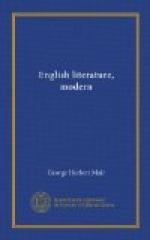For Richardson’s purpose, it answered admirably, and he used it with supreme effect. Particularly he excelled in that side of the novelist’s craft which has ever since (whether because he started it or not) proved the subtlest and most attractive, the presentation of women. Richardson was one of those men who are not at their ease in other men’s society, and whom other men, to put it plainly, are apt to regard as coxcombs and fools. But he had a genius for the friendship and confidence of women. In his youth he wrote love-letters for them. His first novel grew out of a plan to exhibit in a series of letters the quality of feminine virtue, and in its essence (though with a ludicrous, and so to speak “kitchen-maidish” misunderstanding of his own sex) adheres to the plan. His second novel, which designs to set up a model man against the monster of iniquity in Pamela, is successful only so far as it exhibits the thoughts and feelings of the heroine whom he ultimately marries. His last, Clarissa Harlowe is a masterpiece of sympathetic divination into the feminine mind. Clarissa is, as has been well said, the “Eve of fiction, the prototype of the modern heroine”; feminine psychology as good as unknown before (Shakespeare’s women being the “Fridays” of a highly intelligent Crusoe) has hardly been brought further since. But Clarissa is more than mere psychology; whether she represents a contemporary tendency or whether Richardson made her so, she starts a new epoch. “This,” says Henley, “is perhaps her finest virtue as it is certainly her greatest charm; that until she set the example, woman in literature as a self-suffering individuality, as an existence endowed with equal rights to independence—of choice, volition, action—with man had not begun to be.” She had not begun to be it in life either.




